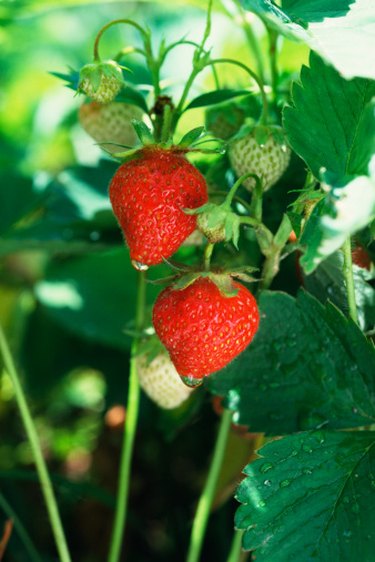
Strawberry leaf blight refers to a fungus that grows on strawberry leaves, appearing like dark spots on the leaves. This fungus rarely ever damages fruit unless the blight is severe, which does not normally occur. There are several treatments that can be used to remove leaf blight. However, you need to be preventative with treatment as infected plants may not show that they have leaf blight until a year after infection, as the fungus will overwinter on old leaves.
Resistant Plants
Video of the Day
Change the strawberry plants you grow to those that are resistant to leaf blight. Many strawberry plants are resistant though many producers have chosen not to plant these strictly for cosmetic purposes. If you have leaf blight every single year, planting resistant plants will reduce the need for constant leaf blight treatment and maintenance. Some new strawberry cultivars that are resistant include Quebec, Oka and Chambly. Make sure all new plants are certified from a disease-free nursery.
Video of the Day
Fungicides
Several fungicides can be used to remove the fungus that causes leaf blight. Make sure you only apply what is necessary as the application of too much fungicide can result in resistant-leaf-blight fungus, which will no longer be killed by the fungicide. Several recommended fungicides for leaf blight include copper, dodine, folpet and captan. Make sure you spray both above and below the plants as the fungicide can only penetrate through the underside of the leaves. Therefore, only spraying above the plants is ineffective.
Planting
Take steps when planting to remove any leaf blight from the plants before it enters the strawberry field. Remove any leaves that show signs of blight before planting. Ensure that the plants are in areas that have good circulation and are in well-drained soil as the blight fungus likes water. If there is not a lot of moisture then the fungus will not grow. You should also check the plants after the strawberry harvest and remove any infected leaves. This will prevent reinfection the next year.
Umbrella Effect
The umbrella effect refers to the process of protecting young strawberry leaves from leaf blight until they can no longer be resistant. These disease-free leaves will then protect any new leafs that may be susceptible. Spraying is only required when rapid growth occurs. Spraying is applied for this time, normally about 15 days. Therefore, the new growth at the top of the strawberry plant will act like an umbrella and protect any leaves below, reducing the amount of fungicide that is needed and the amount of leaf blight that occurs.